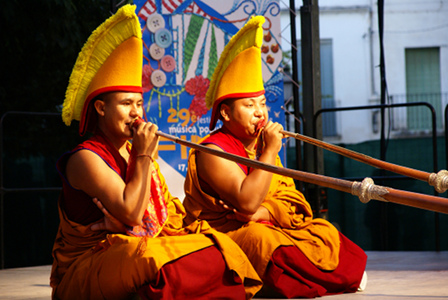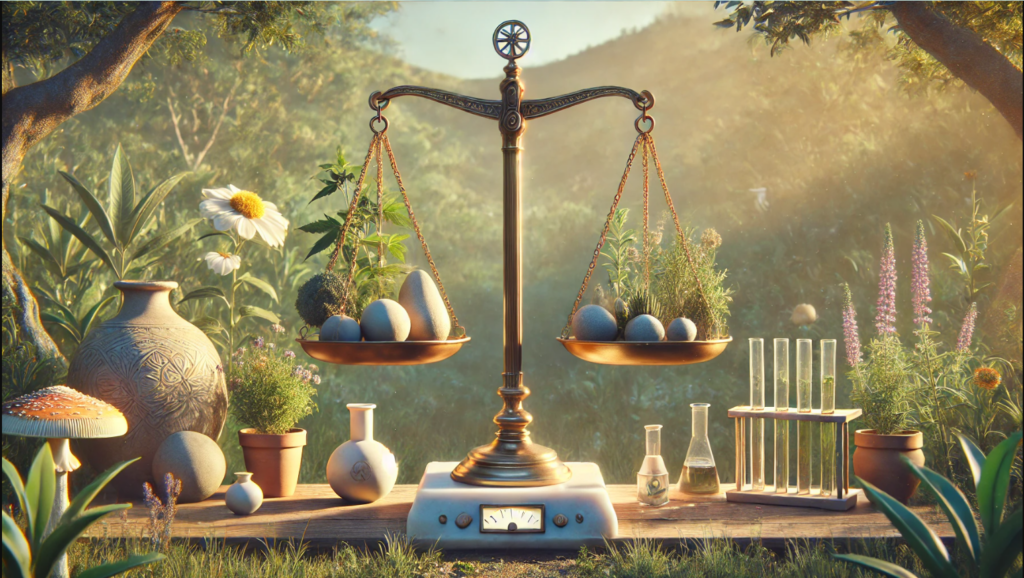The following is a selection from the Umbris Idearum series on The Teeming Brain.
The ancient Tibetan metaphysical texts state that all sound is music, all music is mantra, and mantra is the essence of all sound. Through the use of ritual and mantric power, the Tibetans use sound to effect a specific change in the individual and the environment.
Mantra is a pattern of sound or sound vibration that is based upon primordial sound structures. By their sheer inherent potency and disciplined execution, these concentrated essential energies bring about direct spiritual phenomenon.
– -From the liner notes for Cho-ga, Tantric & Ritual Music of Tibet (Teldec, 1974, LP)
When I was in college I worked at a small music store, often doing 10-hour days with no managerial supervision. This meant that for four years I was privy to an intense engagement with a wide range of music on a daily basis, including everything from Edith Piaf to Throbbing Gristle, and some of the more obscure pleasures in between. Faced with my own predilections, as well as those of the regular customers, I became interested in deleting my preferences, or more importantly, my distaste for certain types of music.
When you work in an environment like that, it’s easy to become a smug connoisseur. While I won’t claim to have avoided that arrogance altogether, I did pursue a program to erase my preferences by using some of the insights I gained from my academic focus on ritual and cognitive philosophy. After four years’ worth of 10-hour shifts, if you’re too picky about what you listen to, you’ll quickly go insane or become a raging asshole.
Each day while driving to work or school, I would randomly choose a radio station by spinning the dial and letting it land wherever it wanted. Then I would enjoy whatever music I encountered. I would enjoy it even if I hated it, and during commercials, because I was brainwashing myself and wasn’t interested in letting others brainwash me, I would turn the dial between stations and listen to white noise. White noise also replaced the station if I landed on talk radio during the random spin. Again, I was interested in brainwashing myself, not letting others do it to me, and this experiment was not about learning to enjoy propaganda but opening up my musical preferences.
When I described the experiment to my collegiate advisor, he warned me that I was playing with fire and could end up erasing preferences that were crucial for having a self-identity in society. However, I knew that initiation, even self-initiation, is a dance with a purifying flame, so I ignored all warnings and continued on.
As you are reading this account many years after I conducted this exercise, you can tell that any irreparable harm to which I was subjected was not damaging enough to suck me into a completely anti-social malignancy. Those self-designed exercises actually laid the groundwork for a much better understanding of sound and its effects on the way we understand ourselves.
Recently, I was excited to see that the sound artist Kim Cascone is developing a program that takes a more positive approach to this kind of aural meditation. He has designed what he calls a ‘Subtle Listening Seminar’ which engages people in developing a better understanding of the nuances of sound:
Subtle Listening is a mode of listening where one’s imagination is open to the sound world around them, helping their inner ear and outer world intersect.
The Subtle Listening workshop is an ongoing workshop for musicians, media artists, filmmakers, composers, producers, sound designers, or any type of artist who wants to sharpen their listening skills.
The workshop uses a wide range of techniques culled from Jungian psychology, Hermetic philosophy, paradox and Buddhist meditation, as well as thirty years of my own experience as a sound artist and electro-acoustic music composer.
Through guided meditation and various types of listening exercises, participants will learn techniques they can use any time to help heighten their sensitivity to the sounds around them.
This methodology brings out the depth of experience that is possible when we interact with sound. Cascone describes one of his recent compositions, “Lunar Gauzes – Alchemisphere One,” which was featured in the Hermetic Library’s audio anthology Magick, Music & Ritual 4, as “subtle lenses, azoth prisms & scrying mirrors to be listened to on headphones during meditation.”
While this may sound obscure, it plays on the fact that much of Cascone’s current work is created not just to be passively engaged but to be used. The inclusion of binaural sounds in these tracks effects an active change in the brainwave patterns of the listener, allowing these compositions to be what Stephan Schwartz, one of the scientists active in studying Remote Viewing, calls a “ground for working” with the ambient mental field.
Nuances of hisses, static, pure beats — all wash over the auditory field, activating a sort of sensory overload that heightens other forms of mentation. Increased ideation, mental visions, and the emergence of memories bring listening beyond melody into the space. Images appear unbidden, and a trans-cranial cinema emerges from the fully engaged senses.
Cascone’s creations are hand-crafted, psyche-summoning sound sculptures that indeed invite “a mode of listening where one’s imagination is open to the sound world around them, helping their inner ear and outer world intersect. ” These tracks act as substructures that bring about visualized equations of symbolic exchange, with sound acting as the ambient bed on which a lucid mental field emerges in which to work.
With this kind of active listening, the value derived from the experience is very much reliant on the capability of the listener him/herself. The delicate sound sculptures Cascone is creating for these meditative pieces develop from a deeper understanding of what he discusses in his 2000 essay “The Aesthetics of Failure: ‘Post-Digital’ Tendencies in Contemporary Computer Music“:
Concepts such as “detritus,” “by-product,” and “background” (or “horizon”) are important to consider when examining how the current post-digital movement started. When visual artists first shifted their focus from foreground to background (for instance, from portraiture to landscape painting), it helped to expand their perceptual boundaries, enabling them to capture the background’s enigmatic character.
The basic composition of “background” is comprised of data we filter out to focus on our immediate surroundings. The data hidden in our perceptual “blind spot” contains worlds waiting to 14 be explored, if we choose to shift our focus there. Today’s digital technology enables artists to explore new territories for content by capturing and examining the area beyond the boundary of “normal” functions and uses of software.
–Kim Cascone, “The Aesthetics of Failure: ‘Post-Digital’ Tendencies in Contemporary Computer Music,” esonancias, 2002 (originally published in Computer Music Journal Vol. 24, No. 4 (Winter 2000)
One of the common critiques of the compositional methods outline by Cascone in this essay is that they forgo the long history of traditional musical development and the understanding of the complex interrelationships of harmonics that underlie Western music. However, Cascone has taken these “glitches” and re-envisioned them with a new kind of formalism that relates directly to a neurological harmonization moving far beyond expressionist abstraction.
To listen to these pieces with classical composition in mind is to miss their importance as meditation tools, which require the active intention of the listener to engage them through a contemporary matrix of science and the sacred. This kind of work accesses all of the insights gained from contemplative traditions, such as the Hermetic and Buddhist influences that Cascone mentions, and brings them into a contemporary setting where they can interact in a relevant way with our current media-saturated culture. With a background that includes professional audio work for film and video games, Cascone brings a craftsmanship to these pieces that isn’t found in most contemporary music of this nature.
For me, Cascone’s work further develops the transformation of ambient urban noise into complex meditation with a delicacy that I’ve never found in the Futurists, the Musique Concrete movement, or the more recent sub-genres specializing in outre sounds. The focus on an active engagement with the soundscape has made me think more of my skull as a sound chamber, a place for an aural engagement that can lead to spaces in which it is possible to work directly with the mental states and symbolic imagery evoked through a dutiful attention to the art of listening.
“The ancient Tibetan metaphysical texts state that all sound is music, all music is mantra, and mantra is the essence of all sound.” Accessing this timeless state is easy. It’s simply a question of what doorway you choose, and how dedicated you are to finding the right key.
Image by Vilanova i la Geltrú courtesy of Creative Commons license.













